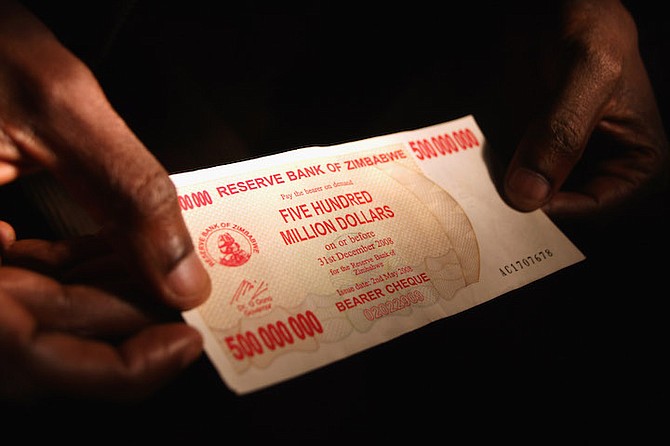ACTIVTRADES WEEKLY
By RICARDO EVANGELISTA
www.activtrades.bs
Imagine going to a restaurant for dinner, looking at the menu and ordering a 3-course meal. By the time desert is about to be served, the waiter approaches the table, quietly informing you that the cost of the set-menu has gone up since you ordered, and advising you to ask for the bill before prices rise again. Or, consider going to the shops with carrier bags full of bank notes and then bringing the goods home in those same, not as full, bags. These situations may sound like comedy sketches, but they aren’t. In some parts of the world such scenarios have been reported during periods of hyper-inflation.
Hyper-inflation describes extreme cases, when the value of a currency becomes so low that central banks are forced to print ridiculously high denomination bank notes. Like for example in Zimbabwe, where the monthly inflation rate reached 79.6 billion percent in 2009, with a one hundred trillion Zimbabwe dollar bill in circulation. That’s 1, followed by 14 zeros! Today, such relics are worth around USD$5, which is what collectors pay for specimens in good condition.
Inflation starts with an excess in demand comparatively to the offer available, and even just a few percentual points of yearly inflation have the potential reduce consumer confidence, which forces companies to decrease and postpone investments, which in turn reduces competitiveness and rising prices. A vicious circle, that if left unchecked can lead a country’s economy to ruin. Thankfully, only a few cases end in hyper-inflation, as timely austerity and strict monetary policies usually deal with potentially dangerous situations.
This is why, in the aftermath of the 2008 financial crisis, austerity was imposed. Inflation-fearing authorities found themselves in the awkward situation of having to choose bailing out financial institutions in detriment of the most vulnerable members of society. The fear was that if too much liquidity was injected into the real economy, in the form of subsidies or state aid, inflation would rise. Instead, the epic size of the western world’s central banks quantitative easing programs served to bail-out large banks, with governments cutting expenditure in social programs in order to balance spending.
Following the economic devastation of the coronavirus pandemic, it appears that a different approach is gaining traction. National authorities are spending more than ever on social programs and subsidies and major central banks, such as the Fed, pledged to keep interest rates at very low levels at least until 2024. Today, most economists defend the theory that inflation is no longer the bogeyman it once was, pointing at Japan as an example; an economy where, instead, deflation is the problem, despite persistently low interest rates and generous government spending. The explanation for this phenomenon is still being debated, with demographic changes and more reliable supply chains usually mentioned as potential reasons.
Nevertheless, a minority of economists still fear inflation and believe that we may be in for a wake-up call next year. As entire populations emerge from lockdown, the urge to spend will be greater than ever, which can potentially cause inflationary pressures due to temporary shortages in supply. Let’s hope such scenario doesn’t materialise, as it is the last thing we would need when recovering from the ravages of the pandemic.





Comments
Use the comment form below to begin a discussion about this content.
Sign in to comment
Or login with:
OpenID